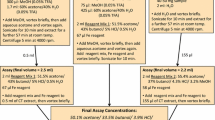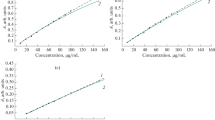Abstract
Factors which establish whether tannin and protein interact to form soluble complexes or precipitates were identified. The ratio of tannin to protein in the reaction mixture influenced solubility of the tannin-protein complexes. At protein-to-tannin ratios larger than the optimum ratio, or equivalence point, soluble tannin-protein complexes apparently formed instead of insoluble complexes. Several other factors influenced the amount of protein precipitated by tannin-containing plant extracts, including the length of the reaction time and the conditions of the tannin extraction. The analytical and ecological significances of soluble complexes were considered. A titration method which allows simultaneous determination of the equivalence point and assessment of the protein-precipitating capacity of any plant extract was developed. It was postulated that in vivo, tannin and protein may not only form insoluble complexes with antinutritional effects, but may also form soluble complexes which have unknown metabolic effects.
Similar content being viewed by others
References
Asquith, T.N., andButler, L.G. 1985. Use of dye-labeled protein as spectrophotometric assay for protein precipitants such as tannin,J. Chem. Ecol. 11:1535–1544.
Bate-Smith, E.C. 1975. Phytochemistry of proanthocyanidins.Phytochemistry 14:1107–1113.
Bradford, M.M. 1976. A rapid and sensitive method for the quantitation of microgram quantities of protein utilizing the principle of proteindye binding.Anal. Biochem. 72:248–254.
Butler, L.G., Rogler, J.C., Mehansho, H., andCarlson, D.M. 1986. Dietary effects of tannis, pp. 141–158,in V. Cody, E. Middleton, and J. B. Harborne (eds.).Plant Flavonoids in Biology and Medicine: Biochemical, Pharmacological, and Structure-Activity Relationships. Alan R. Liss, New York, 1986.
Calderon, P., Van Buren, J.P., andRobinson, W.B. 1968. Factors influencing the formation of precipitates and hazes by gelatin and condensed and hydrolyzable tannis.J. Agric. Food Chem. 16:479–482.
Feeny, P. 1976. Plant apparancy and chemical defense.Recent Adv. Phytochem. 10:1–40.
Fishman, M.L., andNeucere, N.J. 1980. Partial characterization of tannin-protein complexes in five varieties of grain sorghum by automated gel filtration chromatography.J. Agric. Food Chem. 28:477–480.
Fletcher, A.C., Porter, L.J., Haslam, E., andGupta, R.K. 1977. Plant proanthocyanidins. Part 3. Conformation and configuration studies of natural procyanidins.J. Chem. Soc. Perk. I. 1977:1628–1637.
Goldstein, J.L., andSwain, T. 1965. The inhibition of enzymes by tannins.Phytochemistry 4:185–192.
Hagerman, A.E., andButler, L.G. 1978. Protein precipitation method for the quantitative determination of tannins.J. Agric. Food Chem. 26:809–812.
Hagerman, A.E., andButler, L.G. 1980a. Determination of protein in tannin-protein precipitates.J. Agric. Food Chem. 28:944–947.
Hagerman, A.E., andButler, L.G. 1980b. Condensed tannin purification and characterization of tannin-associated proteins.J. Agric. Food Chem. 28:947–952.
Hagerman, A.E., andButler, L.G. 1981. The specificity of proanthocyanidin-protein interactions.J. Biol. Chem. 256:4494–4497.
Hagerman, A.E. 1987. Radial diffusion method for tannin determination.J. Chem. Ecol. In press.
Hagerman, A.E. andKlucher, K.M. 1986. Tannin-protein interactions, pp. 67–76 in V. Cody,E. Middleton, andJ.B. Harborne, (eds.). Plant Favonoids in Biology and Medicine: Biochemical, Pharmacological, and Structure-Activity Relationships. Alan R. Liss, New York, 1986.
Kabat, E.A. 1980. Basic principles of antigen-antibody reactions.Methods Enzymol. 70:3–49.
Martin, J.S., andMartin, M.M. 1982. Tannin assays in ecological studies: Lack of correlation between phenolics, proanthocyandidns, and protein-precipitating constituents in mature foli-age of six oak species.Oecologia 54:205–211.
Martin, M.M., andMartin, J.S. 1984. Surfactants: Their role in preventing the precipitation of proteins by tannins in insect guts.Oecologia 61:342–345.
Martin, M.M., Rockholm, D.C., andMartin, J.S. 1985. Effects of surfactants, pH, and certain cations on precipitation of proteins by tannins.J. Chem. Ecol. 11:485–494.
McManus, J.P., Davis, K.G., Lilley, T.H., andHaslam, E. 1981. The association of proteins with polyphenols.J. Chem. Soc. Chem. Commun. 1981:309–311.
Mehansho, H., Hagerman, A., Clements, S., Butler, L., Rogler, J., andCarlson, D.M. 1983. Modulation of proline-rich protein biosynthesis in rat parotid glands by sorghums with high tannin levels.Proc. Nail. Acad. Sci. U.S.A. 80:3948–3952.
Mole, S., andWaterman, P.G. 1985. Stimulatory effects of tannins and cholic acid on tryptic hydrolysis of proteins: Ecological implications.J. Chem. Ecol. 11:1323–1332.
Nyman, B.F. 1985. Protein-proanthocyanidin interactions during extraction of Scots pine needles.Phytochemistry 24:2939–2944.
Peterson, G.L. 1983. Determination of total protein.Methods Enzymol. 91:95–119.
Potter, D.K., andFuller, H.L. 1968. Metabolic fate of dietary tannins in chickens.J. Nutr. 96:187–191.
Rhodes, D.F., andCates, R.G. 1976. Towards a general theory of plant antiherbivore chemistry.Recent Adv. Phytochem. 10:168–213.
Robbins, C.T., Hanley, T.A., Hagerman, A.E., Hjeljord, O., Baker, D.L., Schwartz, C.C., andMautz, W.W. 1987. Protein digestion, soluble phenolics, and the fecal nitrogen index in cervids.Ecology 68:98–107.
Schultz, J.C., andBaldwin, I.T. 1982. Oak leaf quality declines in response to defoliation by gypsy moth larvae.Science 217:149–151.
Walters, T., andStafford, H.A. 1984. Variability in accumulation of proanthocyanididns (condensed tannins) in needles of Douglas-fir (Pseudotsuga menzjesii) following long-term budworm defoliation.J. Chem. Ecol. 10:1469–1476.
Van Buren, J.P., andRobinson, W.B. 1969. Formation of complexes between protein and tannic acid.J. Agric. Food Chem. 17:772–777.
Zucker, W.V. 1983. Tannins: Does structure determine function? An ecological perspective.Am. Nat. 121:335–365.
Author information
Authors and Affiliations
Rights and permissions
About this article
Cite this article
Hagerman, A.E., Robbins, C.T. Implications of soluble tannin-protein complexes for tannin analysis and plant defense mechanisms. J Chem Ecol 13, 1243–1259 (1987). https://doi.org/10.1007/BF01020552
Received:
Accepted:
Issue Date:
DOI: https://doi.org/10.1007/BF01020552




